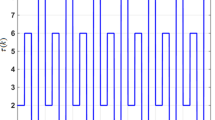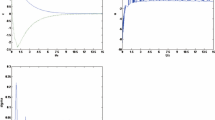Abstract
This study researches the tracking control problem for discrete-time systems with multiple input delays affected by sinusoidal disturbances. This study is organized around the expression of sinusoidal and disturbances and the delay-free transformation. First, based on the periodic characteristic of the sinusoidal disturbance, the sinusoidal disturbances are considered as the output of an exosystem. By proposing a discrete variable transformation, the discrete-time system with multiple input delays and the quadratic performance index are transformed into equivalent delay-free ones. Then, by constructing an augmented system that comprises the states of the exosystems of sinusoidal disturbances, the reference input, and the delay-free transformation systems, the original tracking problem is transformed into the optimal tracking problem for a delay-free system with respect to the simplified performance index. The optimal tracking control (OTC) law is obtained from Riccati and Stein equations. The existent and uniqueness of the optimal control law is proved. A reduced-order observer is constructed to solve the problem of physically realizable for the items of the reference input and sinusoidal disturbances. Finally, the feasibility and effectiveness of the proposed approaches are validated by numerical examples.
Similar content being viewed by others
References
M. Bodson, A. Sacks, and P. Khosla, “Harmonic generation in adaptive feedforward cancellation schemes,” IEEE Trans. on Automatic Control, vol. 39, no. 9, pp. 1939–1944, 1994.
B.-L. Zhang, L. Ma, and Q.-L. Han, “Sliding mode H 8 control for offshore steel jacket platforms subject to nonlinear self-excited wave force and external disturbance,” Nonlinear Analysis: Real World Applications, vol. 14, no. 1, pp. 163–178, 2013.
B.-L. Zhang, Q.-L. Han, X.-M. Zhang, and X. Yu, “Integral sliding mode control for offshore steel jacket platforms,” Journal of Sound and Vibration, vol. 331, no. 14, pp. 3271–3285, 2012.
S. R. Hall and N. M. Wereley, “Performance of higher harmonic control algorithms for helicopter vibration reduction,” Journal of Guidance, Control and Dynamics, vol. 14, no. 4, pp. 793–797, 1993.
M.-C. Fang and T.-Y. Chen, “A parametric study of wave loads on trimaran ships traveling in waves,” Ocean Engineering, vol. 35, no. 8–9, pp. 749–762, 2008.
R. Rebarber and G. Weiss, “Internal model based tracking and disturbance rejection for stable wellposed systems,” Automatica, vol. 39, no. 9, pp. 1555–1569, 2003.
A. Ilchmann and E. P. Ryan, “On tracking and disturbance rejection by adaptive control,” Systems and Control Letters, vol. 52, no. 2, pp. 137–147, 2004.
G.-T. Tang and D.-X. Gao, “Approximation design of optimal controllers for nonlinear systems with sinusoidal disturbances,” Nonlinear Analysis: Theory, Methods and Applications, vol. 66, no. 2, pp. 403–414, 2007.
M. Bodson and S. C. Douglas, “Adaptive algorithms for the rejection of sinusoidal disturbances with unknown frequency,” Automatica, vol. 33, no. 12, pp. 2213–2221, 1997.
M. Riccardo and S. Giovanni, “Global compensation of unknown sinusoidal disturbances for a class of nonlinear nonminimum phase systems,” IEEE Trans. on Automatic Control, vol. 50, no. 11, pp. 1816–1822, 2005.
Z. Ding, “Asymptotic rejection of unknown sinusoidal disturbances in nonlinear systems,” Automatica, vol. 43, no. 1, pp. 174–177, 2007.
Z. Ding, “Adaptive estimation and rejection of unknown sinusoidal disturbances in a class of nonminimum-phase nonlinear systems,” IEE Proceedings: Control Theory and Applications, vol. 153, no. 4, pp. 379–386, 2007.
L. Guo and S. Cao, “Anti-disturbance control theory for systems with multiple disturbances: a survey,” ISA Transactions, vol. 53, no. 4, pp. 846–849, 2014.
H. Koroglu and C. W. Scherer, “Scheduled control for robust attenuation of non-stationary sinusoidal disturbances with measurable frequencies,” Automatica, vol. 47, no. 3, pp. 501–514, 2011.
J. Lin and L. Xie, “H 8 control of linear systems with multiple input delays with application to ATM network congestion control,” Proc. of the 6th World Congress on Intelligent Control and Automation, pp. 21–23, 2006.
E. Altman and T. Basar, “Optimal rate control for high speed telecommunication networks,” Proc. of the 34th IEEE Conference on Decision and Control, vol. 2, pp. 1389–1394, 1995.
E. Altman, T. Basar, and R. Srikant, “Congestion control as a stochastic control problem with action delays,” Proc. of the 34th IEEE Conference on Decision and Control, pp. 1389–1394, 1999.
L. Xiao, A. Hassibi, and J. P. How, “Control with random communication delays via a discrete-time jump system approach,” Proc. of the American Control Conference, vol. 3, pp. 2199–2204, Chicago, 2000.
J. Chu, “Application of a discrete optimal tracking controller to an industrial electric heater with pure delays,” Journal of Process Control, vol. 5, no. 1, pp. 3–8, 1995.
K. P. M. Bhat and H. N. Koivo, “An observer theory for time-delay systems,” IEEE Trans. on Automatic Control, vol. 21, no. 2, pp. 266–269, 1976.
B. Zhou, Z.-Y. Li, and Z. Lin, “Observer based output feedback control of linear systems with input and output delays,” Automatica, vol. 49, no. 7, pp. 2039–2052, 2013.
K. Yakoubi and Y. Chitour, “Linear systems subject to input saturation and time delay: global asymptotic stabilization,” IEEE Trans. on Automatic Control, vol. 52, no. 5, pp. 874–879, 2007.
H. Zhang, G. Duan, and L. Xie, “Linear quadratic regulation for linear time-varying systems with multiple input delays. part I: discrete time case,” Proc. of the Fifth International Conference on Control and Automation, vol. 2, pp. 948–953, Budapest, 2005.
H. Zhang, L. Xie, and G. Duan, “H 8 control of discrete-time systems with multiple input delays,” IEEE Trans. on Automatic Control, vol. 52, no. 2, pp. 271–283, 2007.
H.-G. Zhao, H.-S. Zhang, P. Cui, and X. Lu, “Spectral factorization for multiple input delayed discrete- time systems with applications to control,” International Journal of Control, Automation and Systems, vol. 8, no. 3, pp. 662–666, 2010.
X. Song, H. Zhang, and L. Xie, “Stochastic linear quadratic regulation for discrete-time linear systems with input delay,” Automatica, vol. 45, no. 9, pp. 2067–2073, 2009.
L. Mirkin, “On the approximation of distributeddelay control laws,” Systems and Control Letters, vol. 51, no.5, pp. 331–342, 2004.
G.-Y. Tang and H.-H. Wang, “Suboptimal control for discrete linear systems with time-delays: A successive approximation approach,” Acta Automatica Sinica, vol. 31, no. 3, pp. 419–426, 2005.
H.-H. Wang and G.-Y. Tang, “Observer-based optimal output tracking for discrete-time systems with multiple state and input delays,” International Journal of Control, Automation and Systems, vol. 7, no. 1, pp. 57–66, 2009.
P. Albertos and P. Garcia, “Predictor-observerbased control of systems with multiple input/output delays,” Journal of Process Control, vol. 22, pp. 1350–1357, 2012.
H. T. Banks, M. Q. Jacobs, and M. R. Latina, “The synthesis of optimal controls for linear time optimal problems with retarded controls,” Journal of Optimization Theory and Applications, vol. 8, no. 5, pp. 319–366, 1971.
Author information
Authors and Affiliations
Corresponding author
Additional information
Shi-Yuan Han received his M.S. and Ph.D. from the College of Information Science and Engineering at Ocean University of China in 2009 and 2012. During 2011–2012, he had been as visiting scholar in Discipline of Networks and Communications, School of EECS at Queensland University of Technology, Australia. Currently, he is a researcher in Shandong Provincial Key Laboratory of Network-based Intelligent Computing, University of Jinan, Jinan, 250022, P.R. China. His main research interests include intelligent transport systems, time delay systems and networked control systems.
Dong Wang received his M.S. and Ph.D. from the College of Life Science at Shannxi Normal University of China, in 2007 and 2010, respectively. Currently, he is a researcher in Shandong Provincial Key Laboratory of Network-based Intelligent Computing, University of Jinan, Jinan, 250022, P.R. China. His main research interests include computational intelligence, neurodynamics and nonlinear dynamics system.
Yue-Hui Chen received his B.Sc. degree from the Department of Mathematics (major in Control Theory) at the Shandong University in 1985, and Master and Ph.D. degrees from the School of Electrical Engineering and Computer Science from the Kumamoto University of Japan, in 1999 and 2001, respectively. During 2001 to 2003, he had worked as the Senior Researcher at the Memory-Tech Corporation, Tokyo. Since 2003 he has been a member at the Faculty of School of Information Science and Engineering, Jinan University, where he currently heads the Computational Intelligence Laboratory. His research interests include evolutionary computation, neural networks, fuzzy logic systems, hybrid computational intelligence, computational intelligence grid and their applications in time series prediction, system identification, intelligent control, intrusion detection systems, web intelligence, bioinformatics and systems biology.
Gong-You Tang received his Ph.D. degree in Control Theory and Applications from the South China University of Technology, P. R. China in 1991. He is a Professor at the College of Information Science and Engineering at the Ocean University of China, Qingdao, P.R. China. He is the Editor of the Journal of the Ocean University of China and Control and the Instruments in Chemical Industry. His research interests are in the areas of nonlinear systems, delay systems, large-scale systems, and networked control systems, with emphasis in optimal control, robust control, fault diagnosis and stability analysis.
Rights and permissions
About this article
Cite this article
Han, SY., Wang, D., Chen, YH. et al. Optimal tracking control for discrete-time systems with multiple input delays under sinusoidal disturbances. Int. J. Control Autom. Syst. 13, 292–301 (2015). https://doi.org/10.1007/s12555-013-0271-x
Received:
Revised:
Accepted:
Published:
Issue Date:
DOI: https://doi.org/10.1007/s12555-013-0271-x




